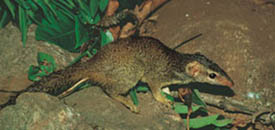Treeshrew facts for kids
Quick facts for kids TreeshrewsTemporal range: Palaeocene recent - present
|
|
|---|---|
 |
|
| Madras Treeshrew (Anathana ellioti) | |
| Scientific classification | |
| Kingdom: | |
| Phylum: | |
| Class: | |
| Infraclass: | |
| Superorder: | |
| Order: |
Scandentia
Wagner, 1855
|
| Families | |
|
|
A treeshrew is a small, furry animal that lives in the warm, wet forests of Southeast Asia. Even though they are called "treeshrews," they are not actually shrews, which are a different type of small mammal. Treeshrews are unique and belong to their own special group called Scandentia. There are about 20 different kinds of treeshrews, and they are found in two main families: Tupaiidae and Ptilocercidae.
Contents
About Treeshrews
Treeshrews are small mammals, often looking a bit like squirrels with long snouts. They are found only in the tropical forests of Southeast Asia. While their name suggests they live in trees, not all treeshrew species spend all their time up high. Some prefer to live on the ground, searching for food among the leaves and roots.
Not a True Shrew
For a long time, scientists thought treeshrews were closely related to shrews, which are small, mouse-like animals. But after more study, they realized treeshrews are actually more closely related to primates (like monkeys and humans) and flying lemurs! This makes them a very interesting group of animals to study.
What Treeshrews Eat
Treeshrews are omnivores, meaning they eat both plants and animals. Their diet includes insects, small vertebrates (like lizards), and fruits. One interesting food they enjoy is the fruit of the Rafflesia plant. This plant is famous for having the largest flower in the world, which smells like rotting meat!
Families of Treeshrews
There are two main families of treeshrews:
- Tupaiidae: This family includes most of the treeshrew species, such as the Northern treeshrew and the Madras treeshrew. They are generally active during the day.
- Ptilocercidae: This family has only one species, the Pen-tailed treeshrew. This unique treeshrew is active at night and has a long, feather-like tail.
Images for kids
-
Northern treeshrew (Tupaia belangeri)
-
Pen-tailed treeshrew (1850 depiction of Ptilocercus lowii)
See also
 In Spanish: Escandentios para niños
In Spanish: Escandentios para niños






